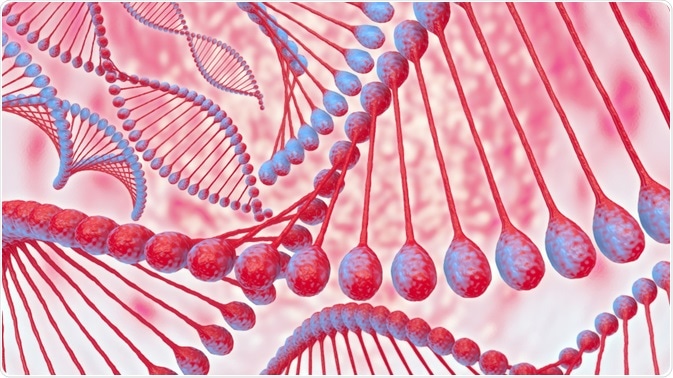Tyramide Signal Amplification (TSA) is an immunohistochemistry technique designed to detect and quantify molecules such as proteins and nucleic acids. It is also referred to as catalyzed reporter deposition (CARD) or tyramine amplification technique (TAT).
In short, TSA involves binding of tyramine to proteins near labeled antibodies, enabling the binding and tracing of target molecules.
 Image Credit: ONX AGENCY / Shutterstock
Image Credit: ONX AGENCY / Shutterstock
TSA reactions
Binding
TSA is based on the intrinsic ability of tyramine to become “sticky” post oxidization or radicalization. The target molecule of interest is initially marked with horseradish peroxidase enzymes, or other peroxidase enzymes, through the use of specific antibodies.
The labeled tissue is thenexposed to biotinylated tyramine and hydrogen peroxide. The binding of the probe to the target can occur by different methods depending on the target. For example, proteins are targeted via immunoaffinity, whereas nucleic acids are targeted by hybridization.
Activated tyramine
Hydrogen peroxide and the phenolic part of tyramine react with horseradish peroxide. The result is a quinone-like structure containing a radical on the C2 group of tyramine. This “activated” tyramine subsequently binds to tyrosine residues in a covalent manner on nearby molecules.
Horseradish peroxidase can then act as an immunoassay label and catalyze the deposition of a fluorophore-tyramine conjugating on the enzyme site and nearby molecules. This results in the enhancement of the fluorescent signal in that location.
The detection can be direct, through fluorescence, or indirect, through, for example, biotin. The biotin that is then bound on the tyramine acts as a tracer molecule that can be visualized. This visualization can be done by standard ABC techniques, or avidin-biotin-enzyme complex.
When a biotin tyramide is not used, the fluorescent signal can be detected immediately and does not require a separate detection step. This direct TSA method gives good spatial resolution and high signal intensity.
Applying TSA
Immunohistochemical detection using TSA was the original use of the method and it can be applied to a variety of specimens such as crystostat sections and cultured cells. Immunohistochemical use of TSA has been applied to detect two targets by primary antibodies raised in the same host species, lacking substantial crosstalk between signals.
However, TSA can be used for fluorescence in situ hybridization (FISH), through which mRNAs in low abundance and short oligonucleotide probes can be detected. TSA is faster than other FISH techniques, which enables the collection of definitive results in a single day.
Improvements from other techniques
TSA methodology improves the dilution of the primary antibody when applied to a variety of biological molecules, such as neurofilaments, serotonin, and B-cells, to name a few. In some, such as B-cells, the dilution could be increased 50-fold.
One worry in the development of the color signals and the potential for interference. In TSA, the substrate conversion and color development occurred independently of the peroxidase enzymes that were already bound to the secondary antibody.
Enzyme immunoassays have gained traction as a valid diagnostic tool in clinical and research settings. The TSA method is flexible and easy to implement in new settings. Further, it makes use of commonly available and widely used immunoassay reagents, with the exception of the biotinylated phenolic compounds.
TSA is applicable to several assay formats and is capable of generating signals on solid phase and in liquid solution. The signals can be chromogenic, fluorescent, chemiluminescent, radioactive, electronic, or others, making it a suitable method for a range of target molecules.
In general, the TSA method can minimize the time taken for an assay, improve performance of the assay, and save valuable components of the assay.
Further Reading